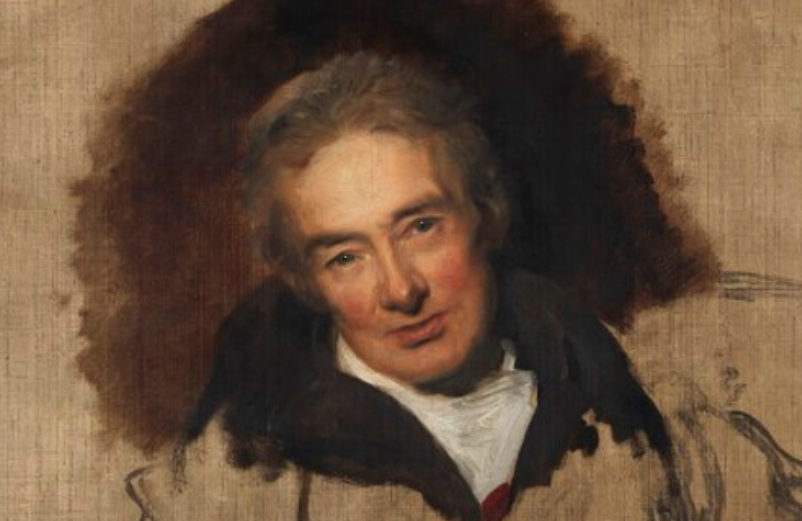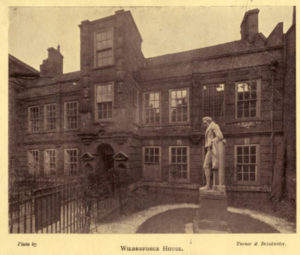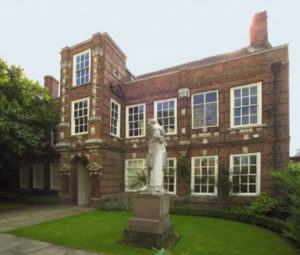
Caterham’s Historical Figures: William Wilberforce
By the Junior History Society
Thursday 4th February 2021
William Wilberforce was a philanthropist, politician and activist, a person who would lay foundations for further human rights. His influence is entwined in the very roots of the founding of Caterham School. He revolutionized the lives of millions across the globe and began a movement, a protest, and a fight that continues to this day.
The Junior History Society will be uncovering the full story of this extraordinary figure who would change the world as we know it. Wilberforce was born in the year 1759, in Hull, a coastal city in the East Riding of Yorkshire. At the time, the city was thriving with the merchant trade as it was set on the Humber, and was the residence to many sailors and merchants.


Above are two photographs of Wilberforce House, a large, old and spacious townhouse in what would have been the centre of Hull at the time, and now a quiet area, centred around a collection of museums. This was William’s childhood home. The family was not wealthy, but well off. It was one of the most fashionable residences at the time and has survived through the ages.
The old, narrow roads of Hull today are quiet, and normally rather deserted. In Wilberforce’s time, it was a completely different scene. There were merchants, sailors, vendors, and people on their weekly errands rushing about. William could have easily heard talk of slavery when he was young. Could this have been where he received early inspiration?
The house was described as a place full of family, laughter, and happiness in his early childhood. However, when he was nine, his father died.
His father had often been away at oceans, as he was a merchant himself, engaged in the Baltic Trade.
His mother faced financial issues and William was sent to live with his aunt and uncle. Wilberforce grew fond of them and began to take an interest in religion before he was brought back to Hull. He even attended George Whitefield’s preachings, another young man born three years earlier than Wilberforce was also attending these preachings, John Townsend, who would go on to found Caterham School.

A painting showing a preaching by George Whitefield.
George Whitefield often visited the household of the Rev. John Townsend, as Hugh Stafford (A History of Caterham School, 1945), writes. It seems that it was no consequence that these two young men of similar ages attended the same preachings and would also support each other’s work. Townsend is known to have talked about the abolition of slavery in his services when he was the Minister of the Jamaica Row Chapel, and Wilberforce was a governor to both educational institutions, The School for The Deaf and Dumb, and The Congregational School that would eventually become Caterham School. It is no mistake to say that Wilberforce and Townsend must have known each other.
Wilberforce was sent to St John’s College in Cambridge when he was seventeen, and he had been the recipient of inherited money from the wills of his relatives, and this allowed him to “live Cambridge life to the full!”, as was described in the age.
As a young man, he is described by his biographer, William Hauge as:
“witty, generous, and an excellent conversationalist.”
Gradually, he became very popular. Another Cambridge student, Thomas Gisborne, lived-in rooms next to Wilberforce’s, and describes him in his room with guests:
“encircled by young men of talent.”
He even befriended William Pitt The Younger, who would become Prime Minister, and as he reached the end of his University career, he began to take an interest in politics, like his friend Pitt, who had been destined for a political career since he was a child. He received a Bachelor and Master of Arts degree, and entered the world as an enthusiastic young man, entirely unaware of the following events that would change his life forever.
The Slave Trade is the three worded phrase that describes the transportation of 12.8 Million human beings from their home country to around the world to labour in plantations and households.
The Trade in Flesh and Blood was a term that Wilberforce and the abolitionists used. It presents the slave trade in its true form. It allowed thousands of people across the world to physically purchase a human life.
The Slave Trade worked in a triangle. Ships were sent from Britain to Africa, where enslaved people were purchased. Then, they were sent on a slave ship to America, commonly to plantations where they had to work and labour. The goods they produced on the plantation was then sent over the sea, back to Britain.
Looking into the National Archives, records show that a ship called The Velmont arrived in America from Africa. When it left Africa, it had carried 600 enslaved alive human beings. When it arrived in America after four weeks, it carried 200 enslaved, alive human beings. In a storm, the sickest enslaved people were thrown overboard to lighten the ship.
In fact, in 1781, a slave ship, called the Zong overthrew over 130 enslaved people off the ship to claim insurance as it was overloaded. Insurance could be claimed on enslaved lives. People had become physical property to be dispensed with for profit.
A plan of the slave ship, The Brookes, from the British Library tells us that the height of the berth compartment during the four-week journey was 2 feet and 7 inches. That is just 79cm. Many died from starvation, disease, illness, and childbirth in a place a little taller than two average-sized rulers.
In the October of 1784, Wilberforce embarked on a tour of Europe with his old schoolmaster, Isaac Milner, that would change his life forever. Milner was the best companion. Wilberforce was completely unaware of what would happen during that trip.
Many people went on similar journeys, known as The Grand Tour. It was a custom that began in the 1660s and continued right up till the 1840s when it began to become less popular. It was a trip through Europe, seeing the famous landmarks, and getting to discover different cultures, but that was a question of whether some grand tourers were doing that or not, sometimes, people like Elgin plundered many items and brought them home. So, it may have been to explore the culture and bring a fair amount home with you. The Adam brothers of neoclassical fame received their inspiration when they had returned from the grand tour. It was normally taken by the upper classes or wealthy, as it was rather expensive.
Roughly a year later after embarking on their Grand Tour, in 1785, Wilberforce writes to announce that he experienced “a classic conversion to Christian Evangelicalism.”
He was stuck right bang in the middle of The Age of Enlightenment, a revolutionary new collection of ideas and beliefs, that would later help cause the French Revolution. Wilberforce’s 20th-century biographer wrote:
“ He was reading about an equal society whilst watching enslaved people pass the window.”
Maybe Wilberforce had an Issac Newton moment, where the apple dropped on his head and he finally and suddenly realised that action needed to be taken to destroy the slave trade. Or perhaps it was a gradual process, in which he thought, read, saw, and debated with Milner.
A noticeable thing was that many people who went on the tour returned with something, maybe plundered statues from the Parthenon, or musical ideas or architectural inspiration. What Wilberforce returned with, however, was a mission. The mission to end slavery, to end The Trade in Flesh and Blood.
Written by Narayan Minhas Ray, Second Year, on behalf of the Junior History Society
The Junior History Society has been involved in projects in discovering the school’s history and traditions. You can find more of their work at CaterhamHistory on Instagram and catshistory on Twitter.
#ThenAndNow #CaterhamConnected
ACKNOWLEDGEMENTS
Mrs. Hebden, Alumni Officer – for her time, effort, and support in helping the Junior History Society produce and publish their work.
Mr. Bagnall, Archivist – for his invaluable information, knowledge on the school’s history, and time and effort in maintaining the school’s archive.
Miss Jones, Teacher of History – for her constant support, understanding, and tireless work in making History come alive for all the pupils at Caterham School.
The National Archives – for their support in the resources and sources in creating this article.
The Wilberforce House Museum, Hull – for their help in uncovering Wilberforce’s early life and supplying us with photographs.
The British Library – for their archives and resources in helping us research Wilberforce’s life.
The Parliamentary Archives, Westminster – for their help in sources to do with the parliamentary actions of the abolition.